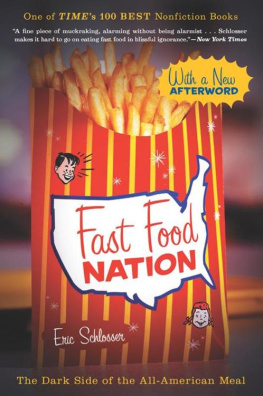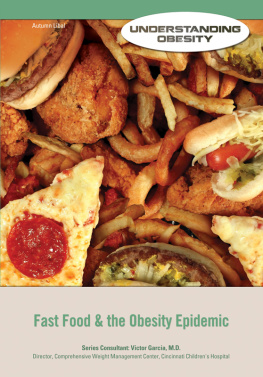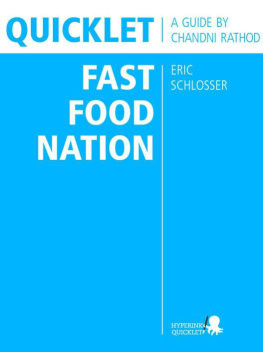Schlosser - Fast Food Nation: The Dark Side of the All-American Meal
Here you can read online Schlosser - Fast Food Nation: The Dark Side of the All-American Meal full text of the book (entire story) in english for free. Download pdf and epub, get meaning, cover and reviews about this ebook. year: 2001, publisher: Houghton Mifflin Harcourt, genre: Politics. Description of the work, (preface) as well as reviews are available. Best literature library LitArk.com created for fans of good reading and offers a wide selection of genres:
Romance novel
Science fiction
Adventure
Detective
Science
History
Home and family
Prose
Art
Politics
Computer
Non-fiction
Religion
Business
Children
Humor
Choose a favorite category and find really read worthwhile books. Enjoy immersion in the world of imagination, feel the emotions of the characters or learn something new for yourself, make an fascinating discovery.
Fast Food Nation: The Dark Side of the All-American Meal: summary, description and annotation
We offer to read an annotation, description, summary or preface (depends on what the author of the book "Fast Food Nation: The Dark Side of the All-American Meal" wrote himself). If you haven't found the necessary information about the book — write in the comments, we will try to find it.
Schlosser: author's other books
Who wrote Fast Food Nation: The Dark Side of the All-American Meal? Find out the surname, the name of the author of the book and a list of all author's works by series.
Fast Food Nation: The Dark Side of the All-American Meal — read online for free the complete book (whole text) full work
Below is the text of the book, divided by pages. System saving the place of the last page read, allows you to conveniently read the book "Fast Food Nation: The Dark Side of the All-American Meal" online for free, without having to search again every time where you left off. Put a bookmark, and you can go to the page where you finished reading at any time.
Font size:
Interval:
Bookmark:

First Mariner Books edition 2012
Copyright 2001 by Eric Schlosser
Afterword Copyright 2012 by Eric Schlosser
All rights reserved
For information about permission to reproduce selections from this book, write to Permissions, Houghton Mifflin Company, 215 Park Avenue South, New York, New York 10003.
www.hmhco.com
The Library of Congress has cataloged the print edition as follows:
Schlosser, Eric.
Fast food nation : the dark side of the
all-American meal / Eric Schlosser.
p. cm.
Includes bibliographical referencesand index.
ISBN 978-0-395-97789-7
ISBN 978-0-547-75033-0 (pbk.)
TX 715. S 2968 2001
394.1'0973dc21 00053886
e ISBN 978-0-547-51824-4
v4.0914
Portions of this book first appeared in Rolling Stone.
for Red
A savage servility
slides by on grease.
ROBERT LOWELL

C HEYENNE MOUNTAIN SITS on the eastern slope of Colorados Front Range, rising steeply from the prairie and overlooking the city of Colorado Springs. From a distance, the mountain appears beautiful and serene, dotted with rocky outcroppings, scrub oak, and ponderosa pine. It looks like the backdrop of an old Hollywood western, just another gorgeous Rocky Mountain vista. And yet Cheyenne Mountain is hardly pristine. One of the nations most important military installations lies deep within it, housing units of the North American Aerospace Command, the Air Force Space Command, and the United States Space Command. During the mid-1950s, high-level officials at the Pentagon worried that Americas air defenses had become vulnerable to sabotage and attack. Cheyenne Mountain was chosen as the site for a top-secret, underground combat operations center. The mountain was hollowed out, and fifteen buildings, most of them three stories high, were erected amid a maze of tunnels and passageways extending for miles. The four-and-a-half-acre underground complex was designed to survive a direct hit by an atomic bomb. Now officially called the Cheyenne Mountain Air Force Station, the facility is entered through steel blast doors that are three feet thick and weigh twenty-five tons each; they automatically swing shut in less than twenty seconds. The base is closed to the public, and a heavily armed quick response team guards against intruders. Pressurized air within the complex prevents contamination by radioactive fallout and biological weapons. The buildings are mounted on gigantic steel springs to ride out an earthquake or the blast wave of a thermonuclear strike. The hallways and staircases are painted slate gray, the ceilings are low, and there are combination locks on many of the doors. A narrow escape tunnel, entered through a metal hatch, twists and turns its way out of the mountain through solid rock. The place feels like the set of an early James Bond movie, with men in jumpsuits driving little electric vans from one brightly lit cavern to another.
Fifteen hundred people work inside the mountain, maintaining the facility and collecting information from a worldwide network of radars, spy satellites, ground-based sensors, airplanes, and blimps. The Cheyenne Mountain Operations Center tracks every manmade object that enters North American airspace or that orbits the earth. It is the heart of the nations early warning system. It can detect the firing of a long-range missile, anywhere in the world, before that missile has left the launch pad.
This futuristic military base inside a mountain has the capability to be self-sustaining for at least one month. Its generators can produce enough electricity to power a city the size of Tampa, Florida. Its underground reservoirs hold millions of gallons of water; workers sometimes traverse them in rowboats. The complex has its own underground fitness center, a medical clinic, a dentists office, a barbershop, a chapel, and a cafeteria. When the men and women stationed at Cheyenne Mountain get tired of the food in the cafeteria, they often send somebody over to the Burger King at Fort Carson, a nearby army base. Or they call Domino S.
Almost every night, a Dominos deliveryman winds his way up the lonely Cheyenne Mountain Road, past the ominous DEADLY FORCE AUTHORIZED signs, past the security checkpoint at the entrance of the base, driving toward the heavily guarded North Portal, tucked behind chain link and barbed wire. Near the spot where the road heads straight into the mountainside, the delivery man drops off his pizzas and collects his tip. And should Armageddon come, should a foreign enemy someday shower the United States with nuclear warheads, laying waste to the whole continent, entombed within Cheyenne Mountain, along with the high-tech marvels, the pale blue jumpsuits, comic books, and Bibles, future archeologists may find other clues to the nature of our civilizationBig King wrappers, hardened crusts of Cheesy Bread, Barbeque Wing bones, and the red, white, and blue of a Dominos pizza box.
OVER THE LAST THREE DECADES, fast food has infiltrated every nook and cranny of American society. An industry that began with a handful of modest hot dog and hamburger stands in southern California has spread to every corner of the nation, selling a broad range of foods wherever paying customers may be found. Fast food is now served at restaurants and drive-throughs, at stadiums, airports, zoos, high schools, elementary schools, and universities, on cruise ships, trains, and airplanes, at K-Marts, Wal-Marts, gas stations, and even at hospital cafeterias. In 1970, Americans spent about $6 billion on fast food; in 2000, they spent more than $110 billion. Americans now spend more money on fast food than on higher education, personal computers, computer software, or new cars. They spend more on fast food than on movies, books, magazines, newspapers, videos, and recorded musiccombined.
Pull open the glass door, feel the rush of cool air, walk in, get on line, study the backlit color photographs above the counter, place your order, hand over a few dollars, watch teenagers in uniforms pushing various buttons, and moments later take hold of a plastic tray full of food wrapped in colored paper and cardboard. The whole experience of buying fast food has become so routine, so thoroughly unexceptional and mundane, that it is now taken for granted, like brushing your teeth or stopping for a red light. It has become a social custom as American as a small, rectangular, hand-held, frozen, and reheated apple pie.
This is a book about fast food, the values it embodies, and the world it has made. Fast food has proven to be a revolutionary force in American life; I am interested in it both as a commodity and as a metaphor. What people eat (or dont eat) has always been determined by a complex interplay of social, economic, and technological forces. The early Roman Republic was fed by its citizen-farmers; the Roman Empire, by its slaves. A nations diet can be more revealing than its art or literature. On any given day in the United States about one-quarter of the adult population visits a fast food restaurant. During a relatively brief period of time, the fast food industry has helped to transform not only the American diet, but also our landscape, economy, workforce, and popular culture. Fast food and its consequences have become inescapable, regardless of whether you eat it twice a day, try to avoid it, or have never taken a single bite.
The extraordinary growth of the fast food industry has been driven by fundamental changes in American society. Adjusted for inflation, the hourly wage of the average U.S. worker peaked in 1973 and then steadily declined for the next twenty-five years. During that period, women entered the workforce in record numbers, often motivated less by a feminist perspective than by a need to pay the bills. In 1975, about one-third of American mothers with young children worked outside the home; today almost two-thirds of such mothers are employed. As the sociologists Cameron Lynne Macdonald and Carmen Sirianni have noted, the entry of so many women into the workforce has greatly increased demand for the types of services that housewives traditionally perform: cooking, cleaning, and child care. A generation ago, three-quarters of the money used to buy food in the United States was spent to prepare meals at home. Today about half of the money used to buy food is spent at restaurantsmainly at fast food restaurants.
Next pageFont size:
Interval:
Bookmark:
Similar books «Fast Food Nation: The Dark Side of the All-American Meal»
Look at similar books to Fast Food Nation: The Dark Side of the All-American Meal. We have selected literature similar in name and meaning in the hope of providing readers with more options to find new, interesting, not yet read works.
Discussion, reviews of the book Fast Food Nation: The Dark Side of the All-American Meal and just readers' own opinions. Leave your comments, write what you think about the work, its meaning or the main characters. Specify what exactly you liked and what you didn't like, and why you think so.














